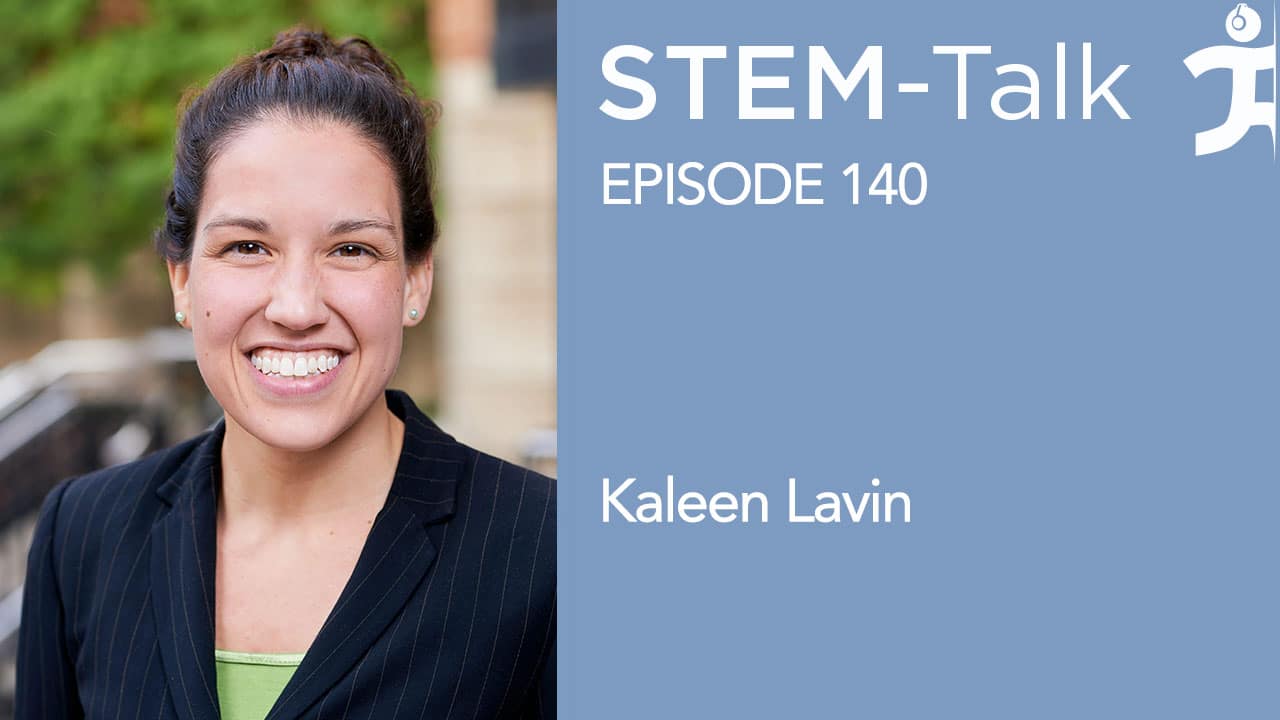STEM-Talk
Episode 140: Kaleen Lavin on the benefits of exercise on Parkinson’s and “inflammaging”
// Aug 13, 2022

Today we would like to introduce you to one of our newest colleagues here at IHMC, Dr. Kaleen Lavin, a research scientist who investigates the molecular mechanisms by which the body adapts and reacts to stressors such as exercise, training and aging.
Kaleen came onboard at IHMC last year and is known for her use of computational biology techniques as a means to understand and improve human health, performance and resilience.
She also is interested in the use of exercise as a countermeasure for a range of disease conditions, including neurodegenerative diseases such as Parkinson’s disease. Today we will talk to her about some of her most recent work that examined the molecular effects of exercise training in skeletal muscle and in people with Parkinson’s.
We also talk to Kaleen about her recent paper that took a comprehensive look at the current literature surrounding the molecular and cellular processes underlying the molecular benefits that exercise induces in humans. The paper appeared earlier this year in Comprehensive Physiology and was titled, “State of Knowledge on Molecular Adaptations to Exercise in Humans.”
Kaleen is a graduate of Georgetown University, where she earned a bachelor’s degree in biology. She also earned a master’s in sports nutrition and exercise science from Marywood University in Pennsylvania and a Ph.D. in human bioenergetics from Ball State University in Indiana.
Show notes:
[00:03:02] Dawn opens the interview mentioning that Kaleen grew up in Scranton, Pennsylvania, and asks Kaleen about her passion for music as a youth. [00:03:25] Ken asks Kaleen about her high school years and how she became a competitive swimmer. [00:04:26] Dawn mentions that Kaleen was an excellent student growing up, but that it wasn’t until her junior year of high school that she became interested in science. Dawn asks if it were a teacher who inspired Kaleen. [00:05:21] Dawn asks what led Kaleen to attend Georgetown University after graduating from high school. [00:05:57] Dawn asks if Kaleen knew she wanted to major in biology when she first arrived on campus at Georgetown. [00:06:45] Ken asks about Kaleen’s experience of becoming a part of the Howard Hughes Program at Georgetown, which led to her gaining experience working in lab. [00:08:47] Dawn mentions that Kaleen transitioned from competitive swimming to running during her undergraduate years, running a marathon and half marathon. Dawn asks if Kaleen’s father, who is an avid marathoner, gave her the incentive to start signing up for marathons. [00:13:19] Dawn asks Kaleen about a faculty advisor who noticed her passion for running and exercise and helped her decide what to pursue for her master’s degree. [00:15:23] Ken asks Kaleen what led her to pursue her master’s at Marywood University, a small Catholic University in Scranton. [00:16:56] Ken asks Kaleen what prompted her to pursue a Ph.D. in exercise science at Ball State University, which has one of the longest-standing human performance programs in the country. [00:17:57] Dawn mentions Kaleen’s experience with no-breath laps as part of her training when she was in high school on the swim team. Dawn asks Kaleen to explain what no-breath laps are. [00:19:00] Dawn asks Kaleen about a study she conducted for her master’s thesis at Marywood that examined the effects of controlled frequency breath swimming on pulmonary function. [00:22:13] Ken asks about how Kaleen’s time at Ball State set her up for her post-doc work at Center for Exercise Medicine at the University of Alabama at Birmingham. [00:24:31] Ken asks what it was about UAB that attracted Kaleen to do her post-doc work there. [00:26:08] Dawn asks about a study published in 2017 by a group at UAB led by Marcas Bamman where researchers took people with Parkinson’s disease and ran them through a high-intensity exercise program, finding that you could not only help people preserve some function but also restore some function. [00:28:52] Ken mentions that despite the awareness of Parkinson’s negative impact on motor function, there has been very little attention paid to its impact on skeletal muscle. Ken asks Kaleen to talk about her study that provided insights into the potential mechanistic roles of skeletal muscle. [00:31:33] Dawn mentions that the research Kaleen just discussed was published in a paper titled “Rehabilitative Impact of Exercise Training on Human Skeletal Muscle Transcriptional Programs in Parkinson’s Disease.” [00:31:51] Kaleen talks about her analysis of the dataset from the 2017 study at UAB that was led by Marcus Bamman. Kaleen explains how she was able to identify 706 genes that were differently expressed after rehabilitative training, and how this work strengthens our understanding of skeletal muscle as a communicative tissue in exercise, aging, and neurodegenerative disease. [00:33:38] Dawn asks Kaleen to elaborate on how she ended her paper talking about how future research is needed to determine the influence of exercise training on other levels of phenotypes in Parkinson’s Disease and how skeletal muscle may reflect or orchestrate these changes. [00:35:31] Ken asks Kaleen to talk about her plans for a future clinical trial concerning Parkinson’s at IHMC. [00:37:21] Dawn asks about another study Kaleen conducted that looked at why people respond differently to the same exercise. Dawn also asks Kaleen to talk about why the reduction in skeletal muscle mass with advancing age is such a serious issue. [00:39:20] Ken follows up mentioning that sarcopenia is often thought of as a gradual decline in muscle mass, but often it is a process where there will be a slow gradual trend punctuated with large downward spikes as individuals grow older and experience illness and injury over the years. [00:41:01] Ken mentions that for the aforementioned study, Kaleen examined what occurs at the molecular level to shed light on the impact of resistance training on muscle hypertrophy. Ken goes on to explain that, previously, the UAB lab and others had demonstrated the magnitude of resistance-training-induced muscle hypertrophy is highly variable across individuals, a phenomenon known as interindividual response heterogeneity. [00:43:07] Dawn mentions that Kaleen used two algorithms to assess the evidence of gene networks that link muscle building to gene expressions. Dawn asks why Kaleen decided to proceed this way, and what future research possibilities does this method open up. [00:45:20] Ken asks about the possibility that Kaleen’s study leaves open the idea that exercising in the past leaves a molecular footprint, creating a kind of “muscle memory” that can come back to help us as we age, even if we haven’t kept up the habit of exercise. [00:54:39] Dawn mentions that Kaleen’s 2019 study on the effects of aging and lifelong aerobic exercise on inflammation supports other recent evidence that training is anti-inflammatory. Kaleen explains that the lifelong habit of exercise offers protection against “inflammaging,” which is the experience of chronic low-grade inflammation throughout the aging process. Dawn asks, however, if people who have waited till their 30s or 40s to begin the habit of exercise have passed the window of opportunity to benefit from the protective therapeutic factors that regular training confers. [00:55:55] Dawn explains that Kaleen was recently the lead author of a paper that appeared earlier this year in Comprehensive Physiology titled, “State of Knowledge on Molecular Adaptations to Exercise in Humans.” Dawn explains that this paper was a comprehensive look at the current literature surrounding the molecular and cellular processes underlying exercise-induced benefits and adaptations in humans. Dawn asks Kaleen to explain how the study of exercise as a preventative and therapeutic treatment has been rapidly gaining momentum for the past couple of decades. [00:57:58] Dawn mentions that the National Institutes of Health decided to fund a trial to look at the effects of exercise at the molecular level across a large group of people to build what they’re calling the Molecular Map of Exercise. Dawn asks Kaleen to talk about the consortium that the NIH is funding for this trial, and how Kaleen’s paper ties into that. [01:01:46] Ken asks what kind of response this review paper has received from the broader community. [01:02:49] Ken mentions that Marcas Bamman, who is helping spearhead IHMC’s new Healthspan, Resilience and Performance Complex, recruited Kaleen to become part of this initiative. Ken asks Kaleen what attracted her about this project. [01:04:15] Dawn mentions that Kaleen is heading up a lot of the computational work at IHMC to help the institute’s researchers gain insight into why some people respond better to exercise than others on a molecular level. Dawn goes on to mention that Kaleen is currently working on a number of ongoing projects and asks her to talk about how her work plays into all this research. [01:05:44] Kaleen talks about how it’s essential to have the right tools as researchers’ questions become more complicated. She and a colleague at IHMC recently received funding to enhance what is known as a pathway-level information extractor, a tool more commonly referred to as PLIER. Kaleen talks about how the funding for this project will allow IHMC to build up its algorithm potential and open the door for IHMC researchers to handle higher dimensions of data.[01:07:48] Dawn asks about a paper by a group of researchers out of the Swedish School of Sport and Health Sciences in Stockholm, which examined acute molecular responses to concurrent exercise involving different muscles. [01:09:56] Ken asks if Kaleen thinks that her type of muscle fiber, which is highly skewed toward Type I, has anything to do with her gravitation towards endurance sports [01:11:39] Ken talks about the shift in muscle fiber type seen in the aging population where fast twitch fibers are lost first, leading to some older people maintaining strength but losing explosive power. [01:13:20] Dawn asks if there is a triathlon in Kaleen’s future. [01:14:02] Dawn asks Kaleen about the influence of muscle-fiber type on performance and how that might influence someone in terms of them gravitating toward a particular mode of exercise. [01:15:41] Dawn closes the interview asking about Kaleen’s passion for singing and how she now sings in her church choir.
Links:






